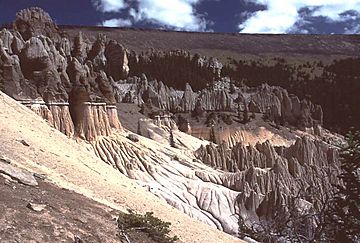La Garita Caldera facts for kids
Quick facts for kids La Garita Caldera |
|
|---|---|

Volcanic ash formations of La Garita Caldera, looking northeast (Wheeler Geologic Monument).
|
|
| Highest point | |
| Geography | |
| Location | Mineral County, Colorado, US, near Creede |
| Parent range | San Juan Mountains |
| Geology | |
| Mountain type | Caldera |
| Last eruption | 26.3 Ma (Fish Canyon Tuff 27.8 Ma) |
The La Garita Caldera is a huge supervolcano in the San Juan Mountains of southwestern Colorado, United States. It's located near the town of Creede. This caldera was formed by one of the biggest volcanic eruptions ever known on Earth. It was an incredibly powerful event!
Contents
When Did La Garita Caldera Form?
The La Garita Caldera was created about 28 million years ago. This happened during a time called the Oligocene Epoch. It was part of a huge period of volcanic activity. Many other calderas formed in Colorado, Utah, and Nevada during this time.
How Much Area Did the Eruption Cover?
The eruption that formed La Garita Caldera was massive. It covered a huge part of what is now Colorado. The ash and rock from the eruption are called the Fish Canyon Tuff. This material spread over at least 11,000 square miles (28,000 square kilometers). Imagine a layer of volcanic rock about 330 feet (100 meters) thick! This shows just how much material was blasted out.
How Big Was the La Garita Eruption?
The eruption of La Garita Caldera was one of the largest in Earth's history. It created the Fish Canyon Tuff. This tuff has a volume of about 1,200 cubic miles (5,000 cubic kilometers). To give you an idea, the eruption of Mount St. Helens in 1980 was much smaller. It only produced about 0.25 cubic miles (1 cubic kilometer) of material.
Scientists use something called the Volcanic Explosivity Index (VEI). This index measures how powerful volcanic eruptions are. The La Garita eruption had a VEI rating of 8. This is the highest rating on the scale.
The energy released by the La Garita eruption was enormous. It was about 5,000 times more powerful than the Tsar Bomba. The Tsar Bomba was the strongest human-made explosive device ever detonated.
This eruption was the second most energetic event on Earth since the Cretaceous–Paleogene extinction event. That event happened 66 million years ago. It was caused by an asteroid impact that led to the extinction of the dinosaurs. The asteroid impact was about 100 times more powerful than the La Garita eruption.
What Is the Geology of La Garita Caldera?
The Fish Canyon Tuff is made of a type of volcanic rock called dacite. Dacite is rich in silica and often found in explosive eruptions. Even though there's a huge amount of it, the Fish Canyon Tuff is very uniform. This means it cooled down as one big unit.
The caldera itself is also very large. It measures about 22 miles (35 kilometers) by 47 miles (75 kilometers). It has an oblong, or oval, shape. Most calderas formed by huge explosions are somewhat oval. Because it's so big and has been worn down by weather, it took scientists over 30 years to figure out its full size. La Garita is now considered an extinct volcano. This means it is not expected to erupt again.
La Garita Caldera was also the source of at least seven other big eruptions. These eruptions produced layers of tuff over 1.5 million years after the main Fish Canyon Tuff eruption.
Scientists also found a unique rock unit called the Pagosa Peak Dacite. This rock is very similar to the Fish Canyon Tuff. It has features of both lava and welded tuff. It likely erupted just before the main Fish Canyon Tuff eruption. The Pagosa Peak Dacite formed from low-energy pyroclastic fountaining. This means it was a less explosive type of eruption. It created dense, flowing clouds of ash and gas called pyroclastic flows. This unit has a volume of about 200 to 300 cubic kilometers.
See also
 In Spanish: Caldera de La Garita para niños
In Spanish: Caldera de La Garita para niños


